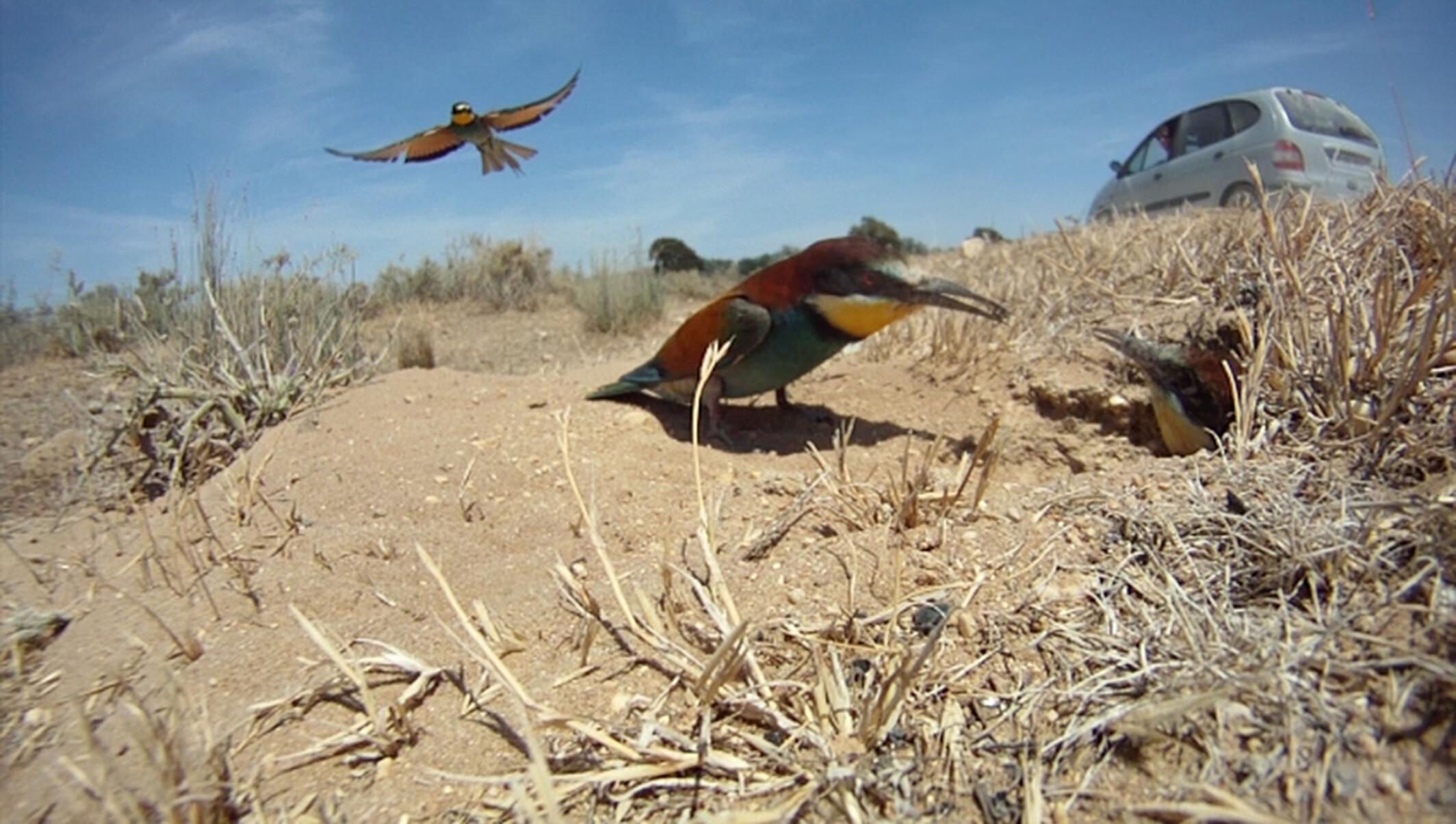Doñana’s bee-eaters now prefer nesting along roadsides due to increasing livestock pressure
A new study by the Doñana Biological Station – CSIC suggests that this shift may be linked to rising livestock pressure.

Camera trap image of European bee-eaters nesting beside a road in Doñana. Photo: Doñana Biological Station - CSIC.
Historically, bee-eaters in Doñana excavated their nests in the intermediate zone between the marshes and the Mediterranean woodland, locally known as la vera. But since the year 2000, their breeding preferences have begun to change. Since then, the number of nests located along roads and tracks has steadily increased, while the number of colonies in natural substrates has declined. A study by the Doñana Biological Station – CSIC concludes that this trend may be driven by the rise in livestock numbers in la vera.
"This is an interesting example of how some species can adapt to human-made environments and even come to prefer them over their original natural habitats," says Marcello D’Amico, a researcher at the Doñana Biological Station – CSIC.
The mixture of sandy and clay-rich soils in Doñana's vera makes it ideal for bee-eaters to dig their nests. These birds excavate tunnels deep enough to protect their eggs from surface temperature extremes. The soil needs to be soft enough to dig but firm enough to avoid collapse.
From natural habitats to roadsides
Historical observational data was crucial for this study. Field notebooks kept by ornithologists between 1970 and 1999 documented at least 17 bee-eater colonies with a total of 1,543 nests in the vera. During those decades, only one colony was reported outside the vera, along a roadside in La Rocina, with about 40 nests — just 2% of all nests recorded at the time.
However, in the years that followed, staff at the Doñana Biological Station began noticing that bee-eaters were increasingly nesting along roads and tracks. This prompted three surveys of active nests in 2011, 2016, and 2022. In 2011, roadside nests made up 61% of the total. By 2016, that number had risen to 94%, and by 2022, a striking 97% of all nests were found in these artificial substrates.
While nesting along roadsides is not unusual for this species, most of Doñana’s roads were built between the late 1960s and early 1970s. Yet, bee-eaters only began nesting there in significant numbers after 2000. What caused this shift?
“This change may be linked to the increasing impact of livestock pressure on colonies located in natural habitats,” explains Jacinto Román, scientific technician at the Doñana Biological Station and lead author of the study. In the late 1990s, the number of grazing animals in the vera more than tripled — a high density that has persisted ever since. Because Doñana lacks steep terrain, bee-eaters have to dig directly into the ground, leaving their nests vulnerable to trampling by livestock. However, this pressure has not affected areas near the Doñana Palace road, which large herbivores tend to avoid.
The risk and rewards of roadside nesting
“Nesting near roads comes with its own set of challenges,” Román notes. “In previous studies, bee-eaters have been observed reacting to passing vehicles as they would to predators — taking flight and emitting alarm calls.” There's also the risk of roadkill. Nevertheless, feeding rates have been observed to double, which could potentially boost reproductive success.
Still, the balance between the costs and benefits of roadside nesting may have limits. So far, scientists have only found bee-eater nests along albero (crushed limestone) roads and low- to medium-traffic paved roads — not on high-traffic or sandy roads.
“Interestingly, although bee-eater nesting along roads and tracks is now widespread in Doñana, not all infrastructure appears suitable for colonies,” D’Amico explains. “Understanding why some roads are used and others aren't will be key to learning how these birds adapt to what would initially seem to be inhospitable environments,” he concludes.
This study opens up a new line of research into the mechanisms that allow some species to adapt and even thrive in human-altered and potentially adverse environments — like roadsides.
Reference
Román J., Blas J., Bastianelli G., Suárez-Couselo M.A., Revilla E., D'Amico M. (2025). Colonizers on the road: European bee-eaters shift nest-site selection to roadside habitats. Ecology. https://doi.org/10.1002/ecy.70125